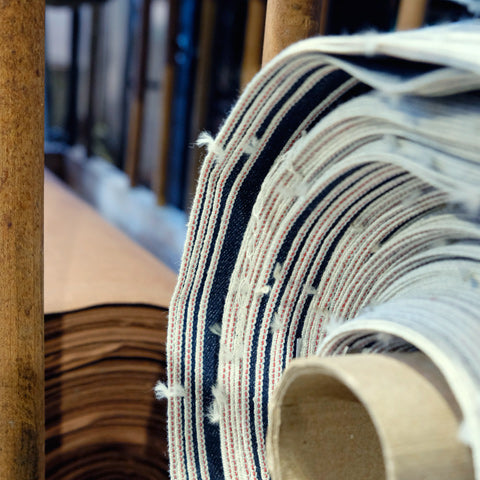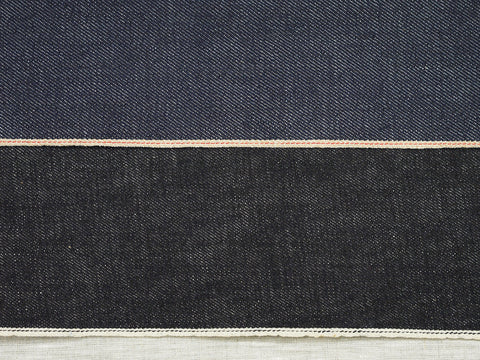What is Raw Denim?
Tons of people come into the store or write us asking what raw denim is and what are the benefits of wearing it? Here's a little background information to help understand the who, what, when, where, and why of Raw Denim.
Defining Raw Denim
Raw or “dry” denim is denim in it’s purest form. Typically made of 100% cotton and left untouched after the dyeing and finishing process, the result is a rigid, durable fabric. Raw denim comes in two forms: sanforized and unsanforized. Due to cotton’s tendency to shrink when wet, sanforization was introduced in 1930 to stop this: a chemical treatment process that prevents shrinkage after wash. Unsanforized denim is left untreated, like the
Levi’s Vintage Clothing 501’s®, and therefore will shrink 5%-10% after soaking. Although raw denim is most closely associated with jeans, garments such as jackets, button-down shirts, dresses, and many others are produced using the fabric.
(Raw, selvedge fabric)
History of Raw Denim
Jacob Davis and Levi Strauss received the first patent for blue jeans in 1873 which they named the Levi's XX (XX was an industry term meaning highest quality). Later, the
XX became the iconic 501®. Although this was the first pair of jeans patented, raw denim’s emergence has no specified date. It’s believed to have begun in the late 1800’s or early 1900’s. During this time, raw selvedge denim was just about the only denim available and most commonly worn by tradesmen and miners. After WWII, American youth culture flourished and their garment of choice: jeans. To keep up with the craze, American factories opted for faster, mass producing looms and abandoned the slower shuttle loom: the machine responsible for creating the finished selvedge* (or “self-edge”) on denim. Many of the shuttle looms were sent to Japan by the US as post-war aid in an effort to re-build their industry.
* Selvedge is not to be confused with raw denim. Selvedge refers to the finished edge of the woven fabric while raw refers to the wash; we’ll cover this in a later blog post!
(Levi's XX)
Raw Denim Today
The many artisanal brands that exist today do their best to differentiate themselves in an industry that prides itself on longstanding methods. A major distinction often pointed out by these brands is the origin of their fabric and whether it's from Japan or the US: the two raw denim production hot spots. Which is better? Well, that's for you to decide. Maybe you prefer the warp and weft of 3Sixteen's Kiroki Mills produced denim, or the deep indigo dye of our Brooklyn Denim Co. jeans from the Cone Mills White Oak Plant. For more on these differences, check out our blog post on American vs Japanese denim, where we cover the difference in production methods of the two countries; or check out all the different raw denim for men and women that we sell at the store.

The Making of Raw Denim
Today, there are many steps in the production of raw denim which vary among brands. However, at its core, raw denim production can be simplified into a few stages - sourcing, spinning, dyeing, weaving, and finishing. Sourcing the cotton used for raw denim is the primary step in production. Choosing what country the cotton is from and how it is collected will vary among manufacturers. Next, spinning includes producing the yarn that is later used in the weaving process. Now, dyeing takes place. In a weave, there are two yarns running perpendicular with one another: the warp (running verticle) and the weft (running horizontal). Indigo dyeing is applied to the yarn used for the warping lines. Now that the warp is dyed and the weft is left natural, weaving occurs. The result is a woven sheet of raw denim fabric. Lastly, finishing takes place. Whether a company sews the denim into different garments themselves or uses larger, more capable facilities, the last step is creating something out of the fabric.

(Cone Mills Shuttle Looms)
The Perks of Raw Denim
Denim is one of the rare items that look better with age. Wearing your unwashed, raw denim as frequently as possible will produce personalized, high contrast fading to the contours of your body - see example below. Another perk of raw denim is wearing a sustainable garment. We recommend not washing your jeans for the first for 6 months(ish) or until they have a grease feel and then after that only as needed. Washing raw denim frequently is discouraged and therefore, saves water.
So now that you're in the know, check out our selection of
raw denim online or come by the shop to pick up your pair today!







Comments
obiri seedirf —
I really love to read much about denim and about the industry players in the denimworld.Thanks alot for sharing your knowledge and hope to bring more articles like this.